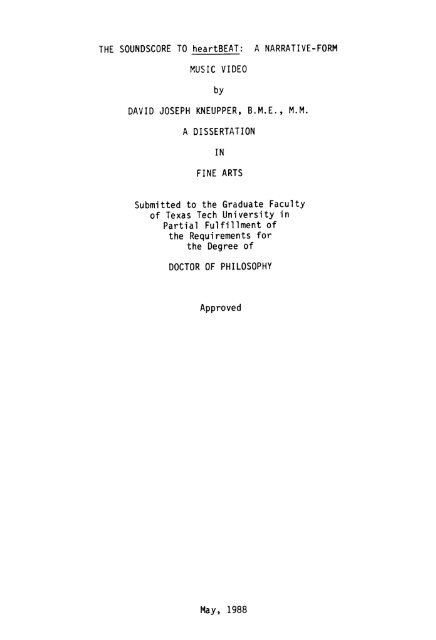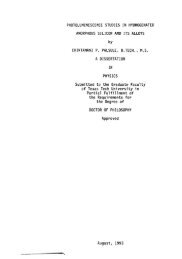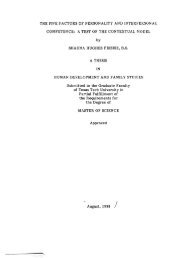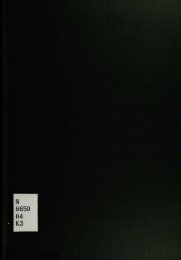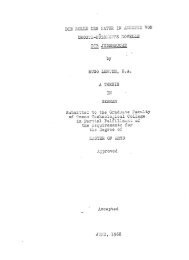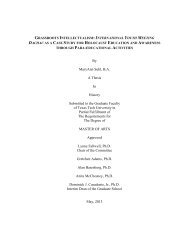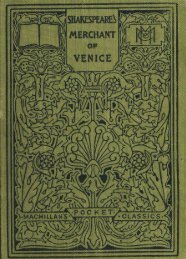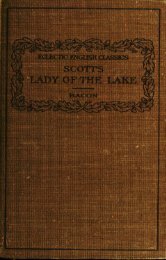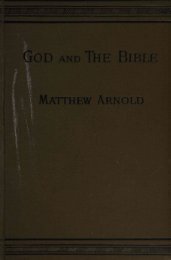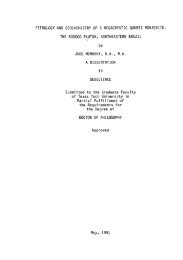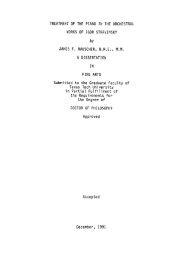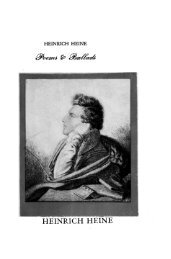THE SOUNDSCORE TO heartBEAT: A NARRATIVE-FORM MUSIC ...
THE SOUNDSCORE TO heartBEAT: A NARRATIVE-FORM MUSIC ...
THE SOUNDSCORE TO heartBEAT: A NARRATIVE-FORM MUSIC ...
Create successful ePaper yourself
Turn your PDF publications into a flip-book with our unique Google optimized e-Paper software.
<strong>THE</strong> <strong>SOUNDSCORE</strong> <strong>TO</strong> <strong>heartBEAT</strong>:<br />
A <strong>NARRATIVE</strong>-<strong>FORM</strong><br />
<strong>MUSIC</strong> VIDEO<br />
by<br />
DAVID JOSEPH KNEUPPER, B.M.E., M.M.<br />
A DISSERTATION<br />
IN<br />
FINE ARTS<br />
Submitted to the Graduate Faculty<br />
of Texas Tech University in<br />
Partial Fulfillment of<br />
the Requirements for<br />
the Degree of<br />
DOC<strong>TO</strong>R OF PHILOSOPHY<br />
Approved<br />
May, 1988
'CO<br />
cp -^<br />
Document and Soundscore<br />
Copyright 1988, David Kneupper<br />
Text and Video<br />
Copyright 1988, Kim Smith<br />
Used with permission
FOREWORD<br />
The following document is submitted as supporting material to the soundscore of<br />
<strong>heartBEAT</strong>. Readers are encouraged to view the artwork in conjunction with an<br />
examination of this document.<br />
<strong>heartBEAT</strong> was a collaborative effort between the author and Dr. Kim Smith,<br />
Department of Art, Texas Tech University. Dr. Smith, executive producer of TV on TV.<br />
produced, wrote, and directed the work, and is the sole author of its text (included in its<br />
entirety in Appendix A).<br />
u
ACKNOWLEDGMENTS<br />
I wish to express my gratiuide to Dr. Mary Jeanne van Appledom for the seven<br />
years of criticism, support, and superb scholarly study, without which this project would<br />
have been a very different thing.<br />
HI
CONTENTS<br />
FOREWORD<br />
ii<br />
ACKNOWLEDGMENTS<br />
iii<br />
HGURES<br />
V<br />
CHAPTER<br />
L HIS<strong>TO</strong>RICAL PERSPECTIVE 1<br />
IL STRUCTURAL DIMENSIONS 7<br />
m. METHODOLOGY AND MATERL\LS 13<br />
IV. CONCLUSIONS 20<br />
ENDNOTES 21<br />
REFERENCES 22<br />
APPENDICES<br />
A. SPOKEN TEXT AND GRAPHIC OVERLAYS 27<br />
B. OPENING REMARKS AT <strong>THE</strong> PREMIERE PER<strong>FORM</strong>ANCE 38<br />
IV
FIGURES<br />
1. A List of Materials Used In the Preparation of the<br />
<strong>heartBEAT</strong> Soundscore 16<br />
2. A List of Structural Divisions Witiiinhearj^EAT 18
CHAPTER I<br />
HIS<strong>TO</strong>RICAL PERSPECTIVE<br />
Introduction<br />
<strong>heartBEAT</strong> is an attempt to relate aural and visual sensation as a single, unified<br />
aesthetic experience. This desire has produced, throughout history, numerous attempts at<br />
combining these two modes of perception. Such efforts have been both theoretical and<br />
practical in nature, originating from the interrelated fields of philosophy, science, art,<br />
drama and music.<br />
Synaesthgsia<br />
The tendency to associate between aural and visual sensation is a common one,<br />
observable in such familiar areas as language. Descriptive phrases such as "loud reds"<br />
and "muted browns" are useful and accepted metaphors. In music, string sounds can be<br />
"bright" and a voice "dark." The association can be more complex, however, not limited<br />
merely to the senses of sight and hearing. The Cherokee Indians had color associations<br />
with the sense of direction. South was seen to be "white," North "blue," East "red,' and<br />
West "black."^ Though in no way conclusive, these examples do suggest a complex and<br />
highly subjective relationship between the senses.<br />
This relationship is known as synaesthesia. Traditionally, the term describes a<br />
particular psychophysical experience, in which the stimulation of a single sense arouses<br />
images from the other senses. To such an individual, the sound of a bassoon may have a<br />
characteristic color and taste, as well as sound. One of the most common manifestations<br />
of the synaesihetic experience is "colored hearing." Widely noted by researchers in the<br />
early part of this century, synaesthetic individuals were reported as having strong color<br />
sensations from a variety of auditory stimuU.^ One blind subject, for example,<br />
professed a sudden understanding of the color "purple," as "the sound of a trumpet.'
Svnaestheric Art<br />
Synaesthesia also refers to a class of artworks which attempts to combine media,<br />
engaging two or more senses simultaneously with a single presentation. It is in this sense<br />
that <strong>heartBEAT</strong> may be regarded as synaesthetic. Image, music, spoken text, graphics<br />
and sound effects are combined and presented through the medium of television.<br />
Synaes±etic conventions can be observed across a broad historical range of<br />
creative thought. Synaesthetic elements constitute central aesthetic features of such<br />
established artforms as opera and ballet Most recently, film and television have emerged<br />
as important new synaesthetic artforms, and are enjoying growing attention by both artists<br />
and the public as serious aesthetic media.<br />
Aristotle<br />
Historical Thought<br />
The plausibility of a link between the senses was discussed as early as the fourth<br />
century B.C. by Aristotie. He believed that our ability to perceive sensation lies in a<br />
single faculty of perception.<br />
May we not, then, conceive this faculty which perceives white<br />
and sweet to be one qua indivisible in its actualization, but<br />
different, when it has become divisible in its actualization.-^<br />
Aristotle believed that taste, sight, hearing, touch and smell were monitored<br />
simultaneously by this one sense. Individual sensations were combined by the beholder<br />
into the perception of an object (or experience) as a whole.<br />
Newton<br />
Isaac Newton believed that a physical relationship existed between sound and light<br />
and attempted numerous models of his theory in drafts for the Opticks."^ Newton<br />
theorized that, as light and sound share in a basic wave nature, colored light has inherent<br />
physical similarities with musical pitch. He divided the speco^m somewhat arbitr:irily<br />
into seven colors (red, orange, yellow, green, blue, indigo, violet) and presented an<br />
analogy to the seven pitches of the diatonic scale. Newton went even further, however,<br />
postulating properties of light based on the principles of acoustics. He asserted that the<br />
ratio of vibrations from extreme red to extreme violet (opposite ends of the spectnim) ;ire<br />
in a 2:1 ratio of the musical octave. However, his calculations proved less conclusive in<br />
other areas, and in the final version of Opticks. Newton abandoned his attempt at<br />
establishing specific ratios for the color spectrum.
Clavicin Oculaire<br />
The first known color music system was put forth in 1734 by a Jesuit priest and<br />
scholar, Louis Bertrand Castel.^ He constructed the clavicin oculaire. or "harpsichord<br />
for the eyes," an instrument which featured an arrangement of colored tapes, attached to a<br />
keyboard, through which light was passed. These tapes were arranged according to the<br />
color spectrum, though Castel did not adopt Newton's details of pitch and color<br />
equivalences. Rhythmic alternations of keys resulted in corresponding changes in the<br />
colored tapes. Historical accounts of the clavicin oculaire suggest that its practical success<br />
was limited, due largely to technological shortcomings of the period.<br />
The Symbolists<br />
The most intense period of artistic interest in synaesthesia occurred from 1880 to<br />
1930, beginning with the Symbolist movement in 1880. The Symbolists, led by<br />
Baudelaire, Rimbaud and others, held the notion that the primary differences among the<br />
related arts were differences only in their physical nature. Art, literature, music and<br />
drama were seen as signifiers of a single type of aesthetic experience. Charles Henry, a<br />
Symbolist artist and philosopher, predicted that man ultimately would develop "one totally<br />
dynamogeneous art."^ This was to be an integrated, synaesthetic experience designed to<br />
affect the viewer not just aesthetically, but in a holistic, restorative sense. Henry<br />
speculated that this experience would probably not even be regarded as aesthetic, but as<br />
some super-mental environment<br />
New synaesthetic combinations were actively explored during this period.<br />
Literature, long an integral element in drama, was combined synaesthetically with color in<br />
Rimbaud's sonnet Les vovelles. in which each vowel was typeset in the color in which it<br />
appeared to him (A black, E white, I red, Q blue, Ii green).^ The Song of Solomon (text<br />
by Paul Roinard, music by Flamen de Labrely), premiered in Paris in 1891, was designed<br />
to engage the senses of sight, sound and smell.^ Described as "a symphony of spiritual<br />
love in eight mystical devices and three paraphrases," the first section featured vocal<br />
recitations of the vowels I and Q, music in the key of D major, bright orange stage<br />
decorations, and the dispensing of the odor of white violet throughout the hall. Each<br />
succeeding scene had its own particular tonality, vowel combination and odor.<br />
Color Organs<br />
By the end of the nineteenth century, scientific advances in the practical application<br />
of electricity made possible the successful constniction of numerous color organs.'^
4<br />
These instruments usually did not produce music, but attempted to translate music into<br />
color patterns by projecting displays of colored Ught onto a screen. Performances on<br />
color organs were essentially visual accompaniments to performances of musical works.<br />
The most celebrated use of the color organ is in Scriabin's orchestral tone poem,<br />
Prometheus: the Poem of Fire (1908-10). The score includes a clavier a luce or<br />
"keyboard of lights," notated in two parts on one staff The lower part functions as an<br />
optical pedal point, indicating the color of the basic background light flooded throughout<br />
the hall. This color changes gradually throughout the work, denoting the spiritual<br />
evolution experienced by listeners of the music. ^^ The upper part is more active,<br />
involving continuous changes in numerous colored spotiights. A new color is indicated<br />
for each tonal center, and the intensity of the lights follows the dynamics of the music.<br />
Film<br />
Film and Television<br />
The medium of film provided early enthusiasts of color music the first practical<br />
means of creating synaesthetic artworks. Adrian Bemard Klein, an important color music<br />
theorist and builder of several color organs, said of the medium in 1937,<br />
It is sufficient to assert here that the colour film seems by far the<br />
most direct method of reahzing nearly everything which had<br />
occurred to the imagination of the pioneers of colour music.<br />
Hardly the fringe of possibihties has been explored. ^^<br />
Klein saw tremendous advantages in film methods over color organ techniques,<br />
including the elimination of expensive and unique equipment, the precise synchronization<br />
of sound, and an ability to reach a large audience easily. He was particularly sensitive to<br />
the medium's tremendous creative potential to artists. Klein proposed numerous<br />
techniques for the making of an "abstract colour film."^*- These included the preparation<br />
of individual colored cells, animating solid models, and handpainting individual frames of<br />
film with colored dyes.<br />
Cinematography has emerged in the twentieth cenuiry as an important and highl\'<br />
popular artform. Significant and diverse contributions exist in the work of Sergei<br />
Eisenstein ^Alexander Nevskv. 1938, score by Sergei Prokofiev), Walt Disney (Fantasia.<br />
1940), Stanley Kubrick fClockwork Orange. 1971) and Francis Ford Coppola<br />
(Apocalypse Now. 1979). Advances continue in the techniques of film production and<br />
presentation, while an ever-expanding audience, through home video and cable television,<br />
insure its continued success and dissemination.
5<br />
Television<br />
Immediacy. Television, like fikn, presents visual artists with design possibilties of<br />
an enormous range and scope. One the most intriguing (and economical) aspects of<br />
videotape is its immediacy: there is no developing process. The tape is simpl\' rewound<br />
and played back. This presents numerous advantages to an artist wishing to work in a<br />
time-based visual medium. Elements can be manipulated quickly and immediately, with<br />
the results recorded and reproduced in far less time and expense than on film. Video and<br />
sound recording both utilize magnetic tape for storage, and are thus easily combined.<br />
Cultural Identity. Over the past thirty years, television has emerged as a medium<br />
with a unique cultural voice. It is totally familiar at all levels of society, and presents a<br />
broad range of aesthetic and social values. The medium has shaped, and is shaped by,<br />
the culture which has created it.<br />
Television is at times a curiously contradictory experience. Key moments in a<br />
fictional dramatic broadcast (such as the death of a loved one, or a profound moment of<br />
personal discovery) segue incongruously into commercials conceming the values of a<br />
low-calorie soft drink or a financial institution. The medium often presents totally<br />
unrelated information simultaneously. Severe weather bulletins, election results and,<br />
even more self-referentially, scheduling changes, electronically crawl across the bottom of<br />
the television screen during programming of any type, from sporting events to talk<br />
shows.<br />
Many aspects of contemporary life are known to us only through the medium of<br />
television. Our understanding and knowledge of the Vietnam war, for example, was<br />
shaped significantly by the fu-st-hand information gathered and broadcast daily by<br />
television news media from 1965-74. Live television coverage of sporting events,<br />
political debates and church services provides viewers with a range and level of<br />
experience previously unavailable through other mass media sources. As an educational<br />
tool, television has significantly enhanced the practical instruction of such diverse subjects<br />
as surgical techniques, home repairs, and pilot training.<br />
Television speaks to our culture through a large vocabulary of familiar symbols and<br />
conventions. <strong>heartBEAT</strong> not only communicates through these conventions, but<br />
incorporates them as primary design elements of the work. <strong>heartBEAT</strong> expresses its form<br />
and content through (and as) the presentational aspects of television. Contradictor.'<br />
information, rapid changes in content, mood and tone, and kaleidoscopic sound<br />
sequences call attention to (and thus defamiliarize) the medium, functioning<br />
simultaneously as both presentational devices and elements of content. heanBEAT may
e viewed as being as much about television as any of the other literary, musical or<br />
dramatic themes it presents.
CHAPTER n<br />
STRUCTURAL DIMENSIONS<br />
<strong>heartBEAT</strong> is a work of television art, integrating the physical aspects of the<br />
television medium witii the symbols through which it speaks to our culture. The work<br />
draws from the related disciphnes of visual design, drama and music in a musico-dramatic<br />
form uniquely designed for (and about) television. Central to the aestiietic of this work is<br />
the presentation of three distinct, yet interpenetrating levels of meaning simultaneously.<br />
Conceptual Levels<br />
Plot-Narrative Level<br />
On its most obvious, plot-narrative level, <strong>heartBEAT</strong> is the story of a man (MR)<br />
returning home from a long day at the office. He goes to the bathroom and bathes,<br />
shaves and dresses for bed. During these activities, he reflects on his life, his job and his<br />
family. MR goes to bed, falls asleep and dreams.<br />
Psychological Level<br />
As we observe these events, <strong>heartBEAT</strong> explores a second idea: the process of<br />
thinking. At the beginning of the piece, the Host and the Expert/Contestant discuss<br />
dioughts. Graphics appear which read, "THINK." We see Rodin's The Thinker. The<br />
process of thought is explored through the symbols of thought. In a stream-ofconsciousness<br />
style, MR's thought sequences are presented as montages of both image<br />
and sound. Familiar to the viewer at first, these thoughts become more cryptic as the<br />
work progresses. Symbolic elements (the gun, the head. The Thinker, the car horn, an<br />
elephant playing the harmonica, bells, the telephone) reappear throughout the piece in<br />
new combinations and forms. These symbols eventually arrange themselves as large<br />
patterns of elements from which many possible meanings can be derived.
8<br />
Presentational Level<br />
On a third level, the work concerns the medium of television. Suggestive at limes<br />
of such broadcast conventions as newscasts, dramatic series, gameshows and<br />
advertisements, <strong>heartBEAT</strong> communicates through the symbols and conventions of<br />
television. These elements range from specific programming and presentational cliches to<br />
the textural aspects of the medium. Texture is observable in television as the rhythmic<br />
effect generated by interuptions in television programming by advertisements, and<br />
includes the rapid editing styles of newscasts, advertisements, sports broadcasts and<br />
music videos. Graphic elements, such as window inserts and character generation, play a<br />
definitive role in the look and tone of television. Even the remote control device has<br />
contributed significantly to the textural aspect of the medium by encouraging<br />
programming changes by the viewer. By rapidly scanning through available<br />
programming, the viewer participates in a significant presentational aspect of television.<br />
Defamiliarization<br />
All of these features represent the "television-ness" of the medium. As a work of<br />
television art, <strong>heartBEAT</strong> utilizes and exploits the presentational aspects of television.<br />
Both the plot-narrative and the psychological levels of the work are communicated<br />
through the conventions and inherent qualities of the television medium. These<br />
presentational devices are rarely used in a literal way, but are defamiharized through a<br />
variety of structural techniques. Drawing various contextual relationships between<br />
familiar symbols is an important defamiliarizing device used in <strong>heartBEAT</strong>. Graphics<br />
crawl across the bottom of the screen in the manner of a severe weather bulletin, yet they<br />
read "YOU SPEND 2/3 OF YOUR LIFE IN UNDERWEAR." Larger interplays of<br />
context and convention are incorporated as well. Near the end of the piece, a man (the<br />
Ring Announcer) sits by a music stand, strumming the teetii of a handsaw as if it were a<br />
musical instrument. We hear the strumming of a microionally-tuned harp, while a \ oice<br />
reads:<br />
VOICE<br />
Turn out the lights.<br />
The party's over.<br />
All good things must end.<br />
But, tomorrow...<br />
(chuckle)<br />
The game starts again.
9<br />
Before this recitation ends, the sound of someone knocking loudly on a pane of glass is<br />
followed by the sound of a car crash, as the graphic "WINDOWS WTTHOUT PAINS" is<br />
superimposed. These montages of sound and image do not suggest one particular<br />
meaning or experience, but attempt to present constellations of possible meanings.<br />
The Role of Sound<br />
Television Opera<br />
A significant aesthetic dimension of <strong>heartBEAT</strong> is the role sound plays in the work.<br />
Rather than serving in an incidental, background role, sound works dynamically with<br />
visual content and style, communicating not only mood and tone, but the pace of the<br />
dramatic action as well. In this respect, <strong>heartBEAT</strong> resembles opera. In opera, music is<br />
designed to communicate a sung (and often spoken) text, while reinforcing the dramatic<br />
mood and action as well as the symbolic content of the libretto. In <strong>heartBEAT</strong>. music is<br />
augmented with natural, non-musical sounds and electronically processed speech. This<br />
texture is then combined with sequences of visual images which suggest numerous<br />
musico-dramatic dimensions. Though <strong>heartBEAT</strong> does not sound or look like traditional<br />
manifestations of opera, the ontological similarities suggest that it may be regarded not<br />
only as a narrative-form music video, but as a television opera as well.<br />
Synaesthetic Elements<br />
The careful coordination of auditory, visual and conceptual design constitutes a<br />
central aesthetic feature of <strong>heartBEAT</strong>. The synchronization of these elements is<br />
accomplished through a wide variety of structural techniques.<br />
Sound and Visual Edits. Different musical effects were created to reinforce specific<br />
editing techniques. There are musical gestures designed to work with quick edits (the<br />
orchestral hits in Mall Performance One), slow dissolves (the rich synthesizer textures in<br />
the St. SebastianA^enus section), smears (digital effects beneath the fiddle tune as MR and<br />
MS dance), wipes (the record scratch sound during the transition from the Office Dance to<br />
the Star Fantasy), and chromakey effects (the sound montage behind the Star Fantasy).<br />
Leitmotives. <strong>heartBEAT</strong> incorporates a wide array of acoustic and electronic<br />
sounds used in a leitmotivic fashion, reinforcing the repetition of visual, literary, or<br />
conceptual elements. The most important of these is the "Think" motive, symbolized by<br />
the sound of an automobile hom. This motive appears eleven times in a variety of<br />
contexts. The horn is preceded by a drum roll in the opening of each of the four<br />
"Thoughts," and is heard whenever the word is spoken or presented as a graphic. Other
10<br />
leitmotivic elements include the ticking clock, tiie beating heart, and the opening musical<br />
theme.<br />
Sound Effects. Sound effects play an important role in the soundscore to<br />
<strong>heartBEAT</strong>. These devices tend to trigger strong associative responses from viewers,<br />
affording them tremendous impact. In <strong>heartBEAT</strong>. sound effects are presented both in<br />
precise synchronization with visual design (MR shaving, and the robots rolling the large<br />
sphere) and in more loose and subjective ways. For example, the work opens witii a<br />
nineteen-second sound effects montage (crickets, the car hom, a jet airplane landing, an<br />
orchestra tuning up) which swells over a black screen. Though there is a lack of visual<br />
content, attention is aroused in both senses as the viewer looks intently at the screen,<br />
hearing a complex sound sequence but seeing nothing. One is left to provide any number<br />
of possible meanings.<br />
At times, the use of naturalistic sound effects tends to place <strong>heartBEAT</strong><br />
momentarily in a frame of reference closely aligned with everyday life. Over the final<br />
credit roll, sound effects convey the wordless narrative of MR waking in the moming,<br />
eating breakfast, getting in the car and driving to work. The viewer leaves the aesthetic<br />
experience of the work by reading information about the piece and listening to a sequence<br />
of namral, "real life" sounds.<br />
Musical Style<br />
The score to <strong>heartBEAT</strong> is programmatic in form, working closely v,i\h dramatic<br />
action and tone. As with the visual design, the musical style of <strong>heartBEAT</strong> is eclectic,<br />
drawing from a wide range of historic and ethnic forms. For example, a detuned organ<br />
playing a passage in the Phrygian mode accompanies the stylized visual images of St.<br />
Sebastian and Venus, while a dark, Stravinsky-like orchestral texture accompanies the<br />
bubble gum sequence in Mall Performance One. A samba underscores Mall Performance<br />
Three, while footstep patterns of the samba dance punctuate the visual flow. Rock music<br />
textures accompany the Star Fantasy, while a country fiddle plays under the MR and MS<br />
dance sequence. During the underwear scene and the elevator sequence, one hears<br />
soundscores to television advertisements.<br />
<strong>heartBEAT</strong> makes use of a wide variety of acoustic as well as electronically<br />
produced sounds. Digital sampUng provides a primary aesthetic and structiu^al resource<br />
of the work, and permeates the duration of the score. Characteristic examples appear in<br />
the Flying Dance, where a sampled slide whistie creates the unusual ethnic flute effect. In<br />
the bath sequence of MS, and during the Spanish Bride scene, samples of a female voice<br />
provide a critical synaesthetic element.
11<br />
The Spoken Text<br />
The spoken text is a combination of dialogue and styhzed poetic treatments. It has<br />
virtually no plot-narrative function. Instead, the text is used to convey the thoughts of<br />
MR and to relate the psychological and presentational aspects of the piece.<br />
There are six speaking parts: MR, MS, Host, Expert/Contestant, Voice and<br />
Chorus. Each of these parts serves a unique dramatic function, often with numerous<br />
contextual dimensions. For example, the Host and Expert/Contestant dialogues suggest<br />
the question and answer sequences one might observe on talk shows or game shows.<br />
However, the content of these brief dialogues concerns the notion of thought.<br />
HOST<br />
Thoughts?<br />
EXPERT/CONTESTANT<br />
Thoughts?<br />
HOST<br />
Thoughts.<br />
EXPERT/CONTESTANT<br />
Thoughts are cerebral gunshots!<br />
MR, as the main character, actually speaks only one on-camera line in the work.<br />
We observe his spoken part as poetic thought sequences, simple and enigmatic, yet with<br />
their own inner sense of logic:<br />
MR<br />
The head's so thick<br />
Like wood<br />
A forest all my own<br />
But small...<br />
Boxed about<br />
Like a shadow<br />
On the wall.<br />
The Voice speaks through an archetypal television announcer. Lines have peculiar<br />
self-referential qualities, while at the same time bearing a resemblance in tone and content<br />
to a newscast or spoken advertisement.<br />
VOICE<br />
There's only one way<br />
To play it.<br />
It's a wonder<br />
.No one thought of it before.
12<br />
The Chorus resembles free verse in both form and tone. The important Chorus<br />
sections appear during the Line Dance, the Robot Dance, the Flying Dance and the Animal<br />
Dance. The furst letter of each of the key words of these Chorus segments forms the<br />
acronym "SHADOW." The following example is from tiie Line Dance:<br />
CHORUS<br />
Said, said, said, said the Stars.<br />
Said-said, said they<br />
SOOTHINGLY<br />
HAPPILY<br />
ANOl<strong>TO</strong>vlOUSLY<br />
DARINGLY<br />
OmCLALLY<br />
wicKEDLY<br />
Each of the voice parts were processed electronically in different ways. This<br />
convention contributed signiflcantiy to the particular identities of each voice, and aided in<br />
generating interesting and unexpected musical characteristics from readings of the text.
CHAPTER m<br />
METHODOLOGY AND MATERL\LS<br />
<strong>heartBEAT</strong> features an electronically produced soundscore, utilizing current<br />
developments in digital sampling, synthesis, and tape synchronization technologies. The<br />
score was composed, performed, engineered and produced by the author at Broadway<br />
Studios, Lubbock, Texas, and is the result of three years of applied study in these related<br />
technologies.<br />
Methodology<br />
The Post-Score Process<br />
The soundscore to <strong>heartBEAT</strong> was post-scored, or prepared after the visual portion<br />
of the artwork was complete. This allowed for considerable flexibility in sound design<br />
and aided in a more complementary musical contribution to the overall dramatic tone of<br />
the piece.<br />
Background. The post-score process is used widely in preparing audio for film<br />
and television. This method saves producers and directors valuable time when in the<br />
field filming or shooting a work, as critical attention can be shifted away from audio<br />
elements during the filming process. Aesthetically, post-scoring allows for visual design<br />
to remain the primary interpretive vehicle of the script. Music and sound can then be used<br />
to provide subjective reinforcement to dramatic form.<br />
Working Method. In preparing the soundscore, individual scenes were viewed<br />
repeatedly until the visual tone and dramatic content suggested a musical or auditor.'<br />
setting. While watching the screen, music was initially improvised until specific musical<br />
dimensions of the section (tempo, key, and themes) were determined. A click track at the<br />
chosen tempo was then gridded against subsequent playings of the scene. Visual edits,<br />
graphic elements and spoken text could thus be converted into musical time, appearing in<br />
relationship to specific measures, beats, and subdivisions of beats. The primary<br />
13
compositional technique involved modifying and building musical ideas around the<br />
occurrence of specific visual cues which had been converted into musical time.<br />
14<br />
Tape Synchronization<br />
A significant techiucal dimension of the <strong>heartBEAT</strong> soundscore was the<br />
synchronization of sound and image. Audio and video portions of the work had to<br />
remain physically synchronized during all stages of score preparation. This was<br />
accomplished through the use of SMPTE time code. SMPTE (Society of Motion Picture<br />
and Television Engineers) is an audio signal in which bits of data arranged in a sequence<br />
of hours, seconds, minutes, frames, and subframes are encoded.<br />
The use of SMPTE time code synchronization in <strong>heartBEAT</strong> was an integral part of<br />
the production process. A time code stripe, previously recorded onto one of the audio<br />
channels of the videotape, was duplicated onto one of the sixteen tracks of audio tape. A<br />
time code synchronizer monitored and compared the two signals, sending servo<br />
instructions to the capstan motor of the slave machine (in this case, the Fostex E-16)<br />
locking it with the video deck with a measurable acciu^cy of 1/300 of a second.<br />
The Fostex synchronization system contains chase and lock features, automatic<br />
record punch-in and punch-out, the setting of play-to-park values, and numerous other<br />
SMPTE-based functions. By using the foldback feature of the synchronizer (essentially a<br />
time-code "thru" jack) the time code stripe on either the audio or \ ideo tapes can be used<br />
to synchronize any code-based device.<br />
Computer Music Systems<br />
The preparation of the score to <strong>heartBEAT</strong> made use of numerous developments in<br />
computer music technology. These developments are currently in an industry-wide stage<br />
of rapid growth, with new hardware and software improvements occurring continuously.<br />
As background work surrounding the project spanned a three-year period, the production<br />
of <strong>heartBEAT</strong> was characterized by the use of numerous generations of music hardware<br />
and software.<br />
For example, the Kurzweil 250, a digital sampling synthesizer which ser\'ed as a<br />
centerpiece of sound design in <strong>heartBEAT</strong>. underwent two software updates (Versions<br />
1.0 and 2.0) during the early stages of the project. This particular unit was eventually<br />
sold in February, 1988 and replaced by the newly developed Kurzweil 250 RMX<br />
(Version 4.1). Sequencing software was initially limited to the Kurzweil's internal<br />
sequencer. This system was eventually replaced by Southworth Music's Midi Pa int. a<br />
software-based sequencer for the Apple Macintosh. This software offered numerous
improvements over the Kurzweil system, including graphic editing capabilities and a<br />
direct time code lock witii video.<br />
15<br />
Materials<br />
Figure 1 below contains a comprehensive list of equipment used in the preparation<br />
of the <strong>heartBEAT</strong> score. Extensive technical information is available in manuals and<br />
related articles (see References), and no attempt is made here at a further contribution to<br />
this area.<br />
Structure<br />
Musical Form<br />
<strong>heartBEAT</strong> is a programmatic work, and numerous structural parameters were<br />
pre-determined by the visual portion of the artwork. For example, the lengths of<br />
individual sections, as well as the length of the entire piece, were fixed constants when<br />
compositional efforts began.<br />
The overall musical form was derived from the inherent structural dimensions of<br />
the video. Upon examining the video for structure, it became evident that a clear musical<br />
form was suggested: a prelude (exposition) is followed by four discrete, yet inten-elated<br />
inner movements (development). A closing section (recapitulation) leads directiy into a<br />
coda.<br />
Stmcmral Divisions<br />
Figure 2 below lists individual scenes and their respective lengths in seconds. This<br />
Hst also represents divisions in musical form.
Sound Generating Devices<br />
Kurzweil 250 and 250 RMX<br />
Yamaha TX7<br />
Yamaha TX416<br />
Yamaha 8IZ<br />
Yamaha RX5<br />
Roland D50<br />
Keyboard Controllers<br />
Kurzweil 250<br />
Yamaha KX88<br />
Recorders<br />
Soundcraft SCM 380 (24-track)<br />
Fostex E-16 (16-track)<br />
Revox (2-track)<br />
Otari 5050 Series m (2-track)<br />
Consoles<br />
SoundWorkshop Series 30 (28-channel)<br />
Fostex 450 (16-channel)<br />
Processing Devices<br />
Yamaha SPX90n<br />
Yamaha Rev 7<br />
Eventide Harmonizer H949<br />
Video Deck<br />
Sony 5850<br />
Synchronization Equipment<br />
Fostex 4030 Synchronizer<br />
Fostex 4035 Synchronizer Controller<br />
Southworth Music's Jambox/4<br />
Computers and Software<br />
Apple Macintosh 512K and MacPlus<br />
Southworth Music's MidiPaint (ver. 1.0<br />
Opcode's DX/TX Patch Librarian and Editor<br />
Kurzweil Music Systems' Macattach (ver. 2.0) and OLS<br />
16<br />
Figure 1. A List of Equipment Used in the Preparation of the <strong>heartBEAT</strong><br />
Soundscore.
17<br />
Microphones<br />
Neuman U87<br />
ShureSM81<br />
Monitors<br />
JBL 4406, 4408<br />
Yamaha NS10<br />
Amplifiers<br />
Crown D-75<br />
Figure 1 (cont.)
Prelude<br />
(Exposition)<br />
Movement One<br />
(Development)<br />
Movement Two<br />
Movement Three<br />
Movement Four<br />
20<br />
04<br />
40<br />
19<br />
10<br />
23<br />
21<br />
02<br />
37<br />
13<br />
13<br />
06<br />
51<br />
07<br />
14<br />
15<br />
35<br />
14<br />
:41<br />
:14<br />
:09<br />
:15<br />
:11<br />
:11<br />
:13<br />
:53<br />
:25<br />
:40<br />
:16<br />
.31<br />
22<br />
36<br />
13<br />
36<br />
Intro (over black)<br />
<strong>heartBEAT</strong> (tide)<br />
Credits<br />
MR in Car (Host and Expert/Contestant)<br />
Driveway; LATE<br />
MR in Bathroom (Mirror Performances)<br />
Office Dance<br />
MR in Minor<br />
Star Fantasy<br />
MR in Bathroom<br />
Hostage Scene<br />
Underwear<br />
MR Bathes<br />
FOUR THOUGHTS<br />
MR Shaving<br />
THINK #1<br />
Mall Performance One<br />
Huntress<br />
Line Dance<br />
Lab Technician and Intertitie<br />
MR in Bathroom<br />
THINK #2<br />
Mall Performance Two<br />
Ring Announcer<br />
Telephone Girl<br />
Robot Dance<br />
Elevator Woman and Intertitie<br />
MR in Bathroom<br />
THINK #3<br />
Mall Performance Three<br />
St. Sebastian and Venus<br />
Rying Dance<br />
Spanish Bride and Intertitie<br />
MS Batiies<br />
18<br />
List of Structural Divisi ons' Witiiin <strong>heartBEAT</strong>
Closing Section<br />
(Recapitulation)<br />
Cpd^<br />
:06<br />
:24<br />
:18<br />
:21<br />
:41<br />
:16<br />
:27<br />
:24<br />
:35<br />
:15<br />
:24<br />
:38<br />
1:23<br />
18:50<br />
THINK #4<br />
Mall Performance Four<br />
Boy and Girl<br />
Fishing<br />
Animal Dance<br />
Man with Saw and Intertitie<br />
MR and MS In Bedroom<br />
MR and MS Sleep<br />
Hostage Nightmare<br />
Starchild Dream<br />
Dream of Adam and Eve<br />
MR and MS/ THINK<br />
Credit Roll<br />
<strong>TO</strong>TAL LENGTH<br />
19<br />
Figure 2 (cont.)
CHAPTER IV<br />
CONCLUSIONS<br />
In the author's survey of artworks of this kind, it is evident that the often superb<br />
conceptualization and execution of visual design in television art has not always matched<br />
with an equal attentiveness to sound design. This has been due largely to technological<br />
limitations. Until recentiy, tape synchronization technologies were expensive capabilities<br />
to support, and were thus largely unavailable to projects with limited budgets. The advent<br />
of computer music technology has made the creation of large and complex soundscores a<br />
logistic and economic possibility as well, affording composers and producers total,<br />
flexible control of a synchronized musical score.<br />
The creation of a carefully designed and executed soundscore was a primary<br />
objective in <strong>heartBEAT</strong>. Considerable attention was addressed to the engineering and<br />
production aspects of the work. As a result, noise levels have been kept to an appreciabl><br />
low level, and the final mix is characterized by the careful balance and placement of<br />
sounds in a 180-degree stereo spectrum.<br />
<strong>heartBEAT</strong> will be submitted for broadcast presentation in the United States and<br />
Europe, for closed-circuit presentation in museums and galleries, as well as to major<br />
festivals and competitions. At this writing, the piece has been submitted to tiie Houston<br />
International Film and Video Competition and the Third Coast Music Project in San<br />
Antonio, Texas. Efforts are currently being conducted to arrange for a private release of<br />
<strong>heartBEAT</strong> on VHS, Beta and audio cassette formats.<br />
20
ENDNOTES<br />
^ Lowrie, R. H., "Psychology and Sociology," American Journal of Sociology.<br />
VoL21, 1915,p. 229.<br />
^ WTieeler, Raymond, The Synaesthesia of a BHnd Subject with Comparative Data<br />
from an Asvnaesthetic Blind Subject (Eugene, Oregon: University of Oregon Press,<br />
1921), p. 94.<br />
3 DeSensu. 449a 12-14.<br />
^ The Optical Papers of Isaac Newton, ed. Alan Shapiro (Cambridge: University<br />
Press, 1984) VoL 1, p. 546-47.<br />
^ "Colour and Music," The New Oxford Companion to Music, ed. Denis Arnold<br />
(Oxford: University Press, 1983), Vol. 1, p. 425.<br />
^ IM., p. 424.<br />
' Klein, Adrian Bemard, Coloured Light: An Art Medium (London: The<br />
Technical Press, Ltd., 1937), p. 243.<br />
° Arguelles, Jose A., Charles Henrv and the Formation of a Psychophysical<br />
Aesthetic (Chicago: University Press, 1972), p. 156.<br />
" "Color and Music," The New Grove's Dictionary of Music and Musicians Ed.<br />
Stanley Sadie (London: Macmillan, 1980) Vol. 4, p. 585.<br />
^^ Fabian Bowers, in the preface to Alexander Scriabin's Prometheus: The Poem of<br />
Fire. Op. 60 (London: Ernst Eulenberg, 1980) p. V<br />
11 Klein, p. XIX.<br />
12 Ibid., p. XXIX<br />
21
REFERENCES<br />
Television Artworks<br />
Primary Sources<br />
Berry. Judith. Mu-age (1985). 14 minutes.<br />
Bienvenue, Marcella. Frustrations of a Rock Fan (1984). 16 minutes.<br />
Davidovich, Jaime. Saludos Amigos: Dr. Videovich Goes To Texas (1984).<br />
25 minutes.<br />
Herschmann, Lynn. Loma (1984). 14 minutes.<br />
Smith, Kim. Spotless (1984). 1 minute.<br />
Smith, Michael. Go For It. Mike! (1984). 3 minutes<br />
Yonemoto, Bruce and Norman. Vault (1984). 14 minutes.<br />
Broadcast Media Sources<br />
Alive from Off Center. Public Broadcasting System. Half-hour program.<br />
Arts and Entertainment Channel. Various programming.<br />
Music Television. 24-hour broadcast of music videos.<br />
Nightflight. USA Network. One hour program featuring music videos and other<br />
electronically synesthetic artworks.<br />
Sound Recordings<br />
Periodicals<br />
Kneupper, David. Muad'dib (1986). 17 minutes. 1/4 inch, two-track stereo.<br />
15 ips.<br />
. Trojan Women (1986). 40 minutes. 1/4 inch, two-track stereo.<br />
15 ips.<br />
Secondary Sources<br />
In a field characterized by rapid and continous changes in essential technology,<br />
periodicals gain an important significance as technical references and user forums. Digital<br />
audio technology has generated a number of well-written and researched periodicals<br />
which address new developments in product use and programming. A major inclusion in<br />
this periodical bibliography is the monthly publication. Keyboard. This magazine has<br />
22
23<br />
regular columns and features by leading specialists in all keyboard instruments, from the<br />
piano, organ and harpsichord to the latest in digital keyboards. Performance practice,<br />
programming and technical information , and product development constitute primar\'<br />
editorial thrusts. A useful and readily-obtainable reference, information gleaned from<br />
this and related periodical resources proved invaluable in this study.<br />
Aikin, Jim. 1985. "Digital Sampling Keyboards: What's Available, How They<br />
Work and Why They're Hot." Keyboard 11(12): 76-94.<br />
Blesser, Barry A. 1979. "Digitation of Audio." Journal of the Audio Engineering<br />
Society. 18(10): 146-193.<br />
Bruin, Herbert. 1985. "Volume, the Tyranny of the Beat, Mating Video With<br />
Audio, and Improvisation vs. Originality." Keyboard 11(12): 8.<br />
Byrd, Donald and C. Yavelow. 1985. "The Kurzweil 250 Digital Synthesizer."<br />
Computer Music Journal 10(1): 64-94.<br />
CasaBianca, Lou. 1984. "Computer Primer." Mix 8(5): 38-41.<br />
Cooper, Jim. 1986. "Clearing the Air Surrounding the MIDI Spec." Keyboard<br />
12(7): 80-87.<br />
. 1986. "Data Transmission, Mixing and Filtering." Keyboard 11(12):<br />
104-105.<br />
1986. "Using MIDI To Send and Receive SMPTE Time Code."<br />
Keyboard 12(7): 130-133<br />
De Furia, Steve. 1986. "Digital Envelope Generators." Keyboard 12(3): 88-89.<br />
.1986. "Track Offsets Can Solve Timing Problems." Keyboard<br />
12(8): 114-115.<br />
Dilberto, John. 1986. "The Electro-Acoustic World of Philip Glass." Electronic<br />
Musician 2(10): 35-40.<br />
Doerschuk, Bob. 1985. "The Piano: Can It Survive in the Electronic Age?"<br />
Keyboard 11(12): 76-94.<br />
Fryer, Terry. 1986. "Allocating Memory for Multisamples." Keyboard<br />
12(7): 126.<br />
. 1986. "Better Samples Through Equalization." Keyboard 12(9): 123.<br />
1986. "ControlUng Aliasing by Filtering and Half-Speed Mastering."<br />
Keyboard 12(4): 102<br />
. 1986. "How to Clean Up Your Signals Before They Reach Your<br />
Sampler." Keyboard 12(6): 135.
. 1986. "More Distortion Solutions." Keyboard 12(5): 106-107.<br />
24<br />
. 1986. "Sample Transposition." Keyboard 12(8): 119<br />
. 1986. "Selecting Sampling Rates." Keyboard 12(3): 82-83.<br />
Fryer, T. and D. Milano. 1986. "Outboard Gear: Magic Boxes for Paintins<br />
Sound in a Thousand Colors." Keyboard 12(6): 72-86.<br />
Greenwald, Ted. 1986. "Keyboards in the Professional Studio." Keyboard<br />
12(6): 64-86.<br />
. 1986. "The Synclavier Phenomenon." Keyboard 12(4): 48-59.<br />
Joe, RadcliffeA. 1984. "Computers in the Studio." Mix 8(5): 34-37.<br />
Klapholz, Jesse. 1986. "Synchronizers for Beginners." Music and Sound<br />
Output 6(11): 14-16.<br />
Kneupper, David. 1985. "The Kurzweil 250: Digital Sampling Synthesis is Alive<br />
and Well (and Living in West Texas!)." West Texas Music News 3(6): 5.<br />
Lanser, B. and D. Milano. 1986. "A Simplified Guide to Specs, Levels and Tape<br />
Formats." Keyboard 12(6): 43-56.<br />
and . 1986. "Secrets of Syncing." Keyboard 12(6): 94-104.<br />
Lowrie, R. H. 1915. "Psychology and Sociology," American Journal of<br />
Sociology. Vol 21.<br />
Nathan, Bobby. 1986. "MIDI Tricks." Keyboard 12(7): 122-123.<br />
1986. "Using Compression and Limiting With Keyboards." Keyboard<br />
11(12): 102-103.<br />
Nazarian, Bruce. 1986. "A User's Guide to Triggering Sampled Sounds." Mix<br />
10(6): 110-115.<br />
. 1985. "In Sync: Computerized Productions." Mix 9(6): 58-60.<br />
Oppenheimer, Larry. 1986. "Sampling Primer, Part 1." Mix 10(5): 56-70.<br />
. 1986. "Sampling Primer, Part 2." Mix 10(6): 54-62.<br />
. 1985. "Synthesizer Oriented Studios" Mix 9(6): 18-24.<br />
Pohlmann, Ken. 1984. "Audio Applications: Synchronization." Mix 8<br />
(4):42-46.<br />
Stewart, Dave. 1986. "Using Synthesizers Effectively As Bass Instruments."<br />
Keyboard 12(5): 28-29.
Books and Scores<br />
25<br />
Manuals<br />
Appia, Adolphe. Music and the Art of Theatre. Coral Gables: The University of<br />
Miami Press, 1962.<br />
Arguelles, Jose A. Charles Henry and the Formation of a Psychophysical<br />
Aesthetic. Chicago: University Press. 1972.<br />
Beardsley, Monroe. Aesthetics. Indianapolis: Hackett Publishing, 1981.<br />
Busoni, Ferruccio. The Essence of Music, trans.by Rosamond Ley. London:<br />
Rockliff, 1957.<br />
The Complete Works of Aristotie. Edited by Jonatiian Barnes. Princeton, NJ:<br />
University Press, 1972.<br />
Gombrich, E. H. Art and Illusion. Princeton, NJ: University Press, 1961.<br />
Janson, H. W. History of Art. 2nd ed. New York: Harry Abrams, Inc., 1962.<br />
Klein, Adrian Bemard. Coloured Light: An Art Medium. 3rd edition. London:<br />
Technical Press, Ltd., 1937.<br />
The New Grove Dictionary of Music and Musicians. Edited by Stanley Sadie.<br />
London: Macmillan Publishers, Ltd., 1980.<br />
The New Oxford Companion to Music. Edited by Denis Arnold. Oxford:<br />
University Press, 1983.<br />
The Optical Papers of Isaac Newton. Edited by Alan Shapiro. Cambridge:<br />
University Press, 1984.<br />
Scriabin, Alexander. Prometheus: The Poem of Fire. Op. 60. London: Ernst<br />
Eulenberg, 1980.<br />
Swanston, Hamish F. G. In Defence of Opera. New York: Penguin Books,<br />
1978.<br />
Swan, Alfred J. Scriabin. New York: Da Capo Press, 1969.<br />
Tambling, Jeremy. Opera. Ideology and Film. New York: St. Martin's Press,<br />
1987.<br />
Three Classics in the Aesthetic of Music. New York: Dover Publications, 1962.<br />
Wheeler, Raymond. The Synaesthesia of a Blind Subject with Comparative Data<br />
from an Asvnaesthetic Blind Subject. Eugene, Oregon: University of<br />
Oregon Press, 1921.<br />
dhx 160X: Preliminary Manual. Newton, MA: dbx, Inc., 1980.<br />
Fostex 4030/4035 Owner's Manual. Norwalk, CA: Fostex Corp., 1987.
Jambox/4 Owner's Manual. Harvard, Massachusetts: Southworth Music Systems,<br />
Inc., 1987.<br />
Kurzweil 250 Operator's Manual. Waltham, Massachusetts: Kurzweil Music<br />
Systems, Inc., 1986.<br />
Midipaint Owner's Manual. Harvard, Massachusetts: Southworth Music Systems,<br />
Inc., 1987.<br />
Yamaha KX88 Owner's Manual. Hamamatzu, Japan: Nippon Gakki Co., Ltd.,<br />
1985.<br />
Yamaha RX5 Owner's Manual. Hamamatzu, Japan: Nippon Gakki co. Ltd.,<br />
1987.<br />
Yamaha TX7 Owner's Manual. Hamamatzu, Japan: Nippon Gakki Co., Ltd.,<br />
1985.<br />
Yamaha TX 816 Owner's Manual. Hamamatzu, Japan: Nippon Gakki Co., Ltd.,<br />
1984.<br />
26
APPENDED A: SPOKEN TEXT<br />
AND GRAPHIC OVERLAYS<br />
The following is the script used in preparing the soundscore to <strong>heartBEAT</strong>. It<br />
contains the spoken text, graphic overlays and brief stage directions. The script is<br />
presented here in a slightiy modified form. Changes have been limited to the stage<br />
directions, and were made to more accurately reflect the final version of the work.<br />
<strong>heartBEAT</strong><br />
written by Kim Smith<br />
Voice Characters<br />
MR<br />
MS<br />
Chorus<br />
Host<br />
Expert/Contestant<br />
Voice<br />
Flashing title, alternating red and white, three times:<br />
heart<br />
BEAT<br />
Cascade of automobile headlights with opening credits superimposed. FoUovved by<br />
MR at the wheel, driving home. Passing lights cause face to flash on and off Over<br />
music, a cross between a talk show and a game show. A man's voice serves as the host,<br />
a woman's voice as the expert/contestant's.<br />
HOST<br />
Thoughts?<br />
EXPERT/CONTESTANT<br />
Thoughts?<br />
27
HOST<br />
Thoughts.<br />
EXPERT/CONTESTANT<br />
Thoughts are cerebral gunshots I<br />
28<br />
Car pulls into driveway and lights go out. Over black, the word:<br />
LATE<br />
MR in bathroom. Does several mirror perfonnances.<br />
MR<br />
Yesterday...<br />
Today...<br />
Tommorrow.<br />
He stops and thinks about work.<br />
Office Dance. The graphic "Taking Stock," paper shuffling, etc. Returns abruptiy<br />
to MR in bathroom, leaning into mkror.<br />
MR<br />
I should have been a star.<br />
Star Fantasy: MR as a TV star, scholar, rock star, boxer, and jet fighter ace. MR<br />
then sees himself in the public eye only by being held hostage.<br />
MR<br />
My moment of fame!<br />
Superimposed text crawls over hostage scene:<br />
YOU SPEND 2/3 OF YOUR LIFE IN. . .<br />
UNDERWEAR.<br />
MR's underpants fall to floor. Turns on bathtub faucet.<br />
Bath Dance. Followed by close-up of comb passing through hair, with a<br />
sumpcrimposed '?" dissolving into a superimposed "I". Fade to black. Intertitie:
29<br />
4 THOUGHTS<br />
MR shaving. Classical head appears with the word "think," then a gun and the<br />
number "1" followed by the tiiinker. An image of MR's head appears with "OPAQUE<br />
OBJECT" superimposed.<br />
MR<br />
The head's so thick<br />
Like wood<br />
A forest all my own<br />
But small...<br />
Boxed about<br />
Like a shadow<br />
On the wall.<br />
Mall Performance One: Bubble Gum<br />
EXPERT/CONTESTANT<br />
Thinking...is invisible.<br />
But subject to inflationary cycles.<br />
HOST<br />
And speech?<br />
EXPERT/CONTESTANT<br />
Beautiful...bubbling...breath.<br />
HOST<br />
Very good!<br />
Huntress drawing bow.<br />
HOST<br />
A single word?<br />
MR as Starchild. Superimposed text:<br />
AT A LOSS.
30<br />
HOST<br />
A single word?<br />
Hand holding telephone. Superimposed text:<br />
FOR WORDS.<br />
A bride.<br />
EXPERT/CONTESTANT<br />
A single string...<br />
Plucked<br />
Like a chord.<br />
Line Dance.<br />
CHORUS<br />
Said, said, said, said the Stars.<br />
Said-said, said they<br />
SOOTHINGLY<br />
HAPPILY<br />
ANONYMOUSLY<br />
DARINGLY<br />
OFHCIALLY<br />
WICKEDLY<br />
Lab technician with lightbulb.<br />
VOICE<br />
A grievance will be filed<br />
We're suprised.
That's all.<br />
Just real surprised.<br />
31<br />
Intertitie:<br />
<strong>THE</strong> SEARCH FOR A PERFECT LIGHT<br />
Man examines freshly washed hands. Robot Head followed by gun, numbers, and<br />
tiiinker. MR's hand defamiliarized with "RAGING ROSES" superimposed.<br />
MR<br />
The hand's flat<br />
Like a wallet<br />
A furrowed field<br />
Arid<br />
And clean.<br />
Mall Performance Two: Bowing Noses<br />
CHORUS<br />
The nose knows no rest.<br />
The finger no pause<br />
Action,<br />
And reaction...<br />
The Newtonian Laws.<br />
Ring announcer, holding microphone.<br />
HOST<br />
I'm sorry,<br />
Your time is up.<br />
"Actions speak louder than words."<br />
EXPERT/CONSTESTANT<br />
Of course!
Telephone girl with graphic superimposed:<br />
32<br />
SEEING IS...<br />
BELIEVING<br />
Robot Dance.<br />
CHORUS<br />
Said, said, said, said the Comet<br />
Said-said, said he<br />
SOBERLY<br />
HEATEDLY<br />
APOLOGETICALLY<br />
DIVEN-EL-Y<br />
OFFHANDEDLY<br />
WASPISHLY<br />
Woman with building on fire.<br />
VOICE<br />
There's only one way<br />
To play it.<br />
It's a wonder<br />
No one thought of it before.<br />
Superimpose text:<br />
AN ULTIMATE LUXURY<br />
EASY COME...<br />
EASY GO
MR in batiiroom, checking the pulse in his neck witii a watch.<br />
33<br />
MS<br />
May I come in?<br />
MR clips his fingernails.<br />
Sure!<br />
MR<br />
MR probes chest with his fingers. Woman's head followed by gun, numbers, and<br />
tiiinker. MR's chest defamiliarized with "CLUTCH PURSE" superimposed.<br />
MR<br />
The heart-pump thumps<br />
Like a drum.<br />
Clasping thorns...<br />
And tokens of lasting affection.<br />
Mall Performance Three: Matches<br />
CHORUS<br />
DEEP DEVOTION<br />
So E-Z emotion<br />
A match-maker's dream<br />
A pair<br />
Exhaling worlds in a steady stream<br />
Breathing each others air.<br />
St. Sebastian/Venus with "Talk Show/Game Show" television sound overlay.<br />
EXPERT/CONTESTANT<br />
Tossing the question back to you...<br />
Picture "LOVE."
HOST<br />
Well...<br />
Living stereo,<br />
A binocular view...<br />
34<br />
Flying Dance.<br />
CHORUS<br />
Said, said, said, said the Moon<br />
Said-said, said she<br />
SEVERELY<br />
HEADILY<br />
ABSENTMESIDEDLY<br />
DOUBTFULLY<br />
OPTIMISTICALLY<br />
WISTFULLY<br />
Spanish bride.<br />
VOICE<br />
She, too<br />
Reveals her thoughts.<br />
In order<br />
To be sure of them.<br />
Superimpose text:<br />
BEHIND <strong>THE</strong> MASK<br />
WHERE MEMORIES REGISTER
35<br />
Tub Dance. MS bathes. MR helps MS from the tub. An animal's head appears,<br />
followed by the gun, numbers, and thinker.<br />
Mall Performance Four: Saran Wrap<br />
CHORUS<br />
SALIVA FIRE<br />
Moist, seesaw desire<br />
Birtii<br />
Deatii<br />
Sex<br />
And Money,<br />
Pushing the envelope<br />
Breaking the barrier.<br />
Boy and girl necking on the couch.<br />
CHORUS<br />
PLEASURE<br />
PLEASURE<br />
Heartbeat treasure<br />
Silhouettes on the shade<br />
MR and MS night fishing.<br />
HOST<br />
On a more serious note...<br />
Tissue.<br />
EXPERT/CONTESTANT<br />
Shadow,<br />
From inflammatory depths...<br />
Starlit bodies<br />
Stuttering pleasure<br />
Without measure.
Animal Dance.<br />
36<br />
CHORUS<br />
Said, said, said, said the Sun<br />
Said-said, said he<br />
SILENTLY<br />
HEARTILY<br />
AMBIDEXTROUSLY<br />
DISTANTLY<br />
OPENLY<br />
WAN<strong>TO</strong>NLY<br />
Ring Announcer seated with saw.<br />
VOICE<br />
Tum out the lights.<br />
The party's over.<br />
All good thing must end.<br />
But, tomorrow<br />
(chuckle)...<br />
The game starts again.<br />
Superimpose text:<br />
WINDOWS WITHOUT PAINS<br />
Couple gets into bed, falls asleep. MR then has nightmare about ideas held hostage<br />
by one another. He sees himself as the "starchild" at crossroads. He then witnesses<br />
himself as a primitive Adam. Finally, the faces of MR and MS dissolve into one another,<br />
slowly.
Trading lines.<br />
Graphic:<br />
MR&MS<br />
Witii stars<br />
And space above<br />
And time<br />
And stars below<br />
Watch us<br />
Wiggle<br />
Watch us<br />
Glow.<br />
THINK...<br />
THINK...<br />
THINK...<br />
(cancellation sign)<br />
SINK<br />
37<br />
Slow fade to black. Credits roll over black.
APPENDK B: OPENING REMARKS AT<br />
<strong>THE</strong> PREMIERE PER<strong>FORM</strong>ANCE<br />
<strong>heartBEAT</strong> received its first public performance on March 24, 1988 in Hemmle<br />
Recital Hall, Texas Tech University, Lubbock. A large laser projection system and stereo<br />
sound reinforcement were installed for the presentation. The program featured two other<br />
television artworks, Bruce and Norman Yonemoto's Vault, and Michael Smith's Go For<br />
It. Mike!, which were produced in 1984 by TV on TV.<br />
Introductory remarks were given by Edna Glenn and Sara Waters, both from the<br />
Department of Art, Texas Tech University, and by Kim Smith and the author. The<br />
following script was prepared by Kim Smith.<br />
SARA<br />
Good evening. I'm Sara Waters.<br />
EDNA<br />
And I'm Edna Glenn. We'd like to welcome you to the premiere of <strong>heartBEAT</strong>.<br />
SARA<br />
To begin the evening, we'd like to tell you a littie bit about the TV on TV series,<br />
and to show two previous works that were produced as part of this series.<br />
EDNA<br />
TV on TV. originated four years ago as a project designed to explore a new area<br />
that some were beginning to call "television art." Of course, for many, the two terms,<br />
"television" and "art," have absolutely nothing to do with one another. We might keep in<br />
mind, however, that neither photography nor film were considered proper art media when<br />
they were first invented. Photography was merely the poor man's painting and film the<br />
poor man's theatre. What transformed each of these so called "non-art" media into the<br />
stuff out of which great art could be created, was the discovery that each of these media<br />
had an expressive potential quite different from any other. Thus, photography found its<br />
"voice" in something called "straight photography" while the invention of montage gave<br />
birth to the art of film.<br />
38
39<br />
SARA<br />
This brings us back to TV. Does it have a distinctive voice? When we watch a<br />
classic ftim on TV, we view it in terms of the art of film. When we view an opera or a<br />
theatrical production on TV, we view them in terms of the art of opera and theatre. Why<br />
not, then, view TV in terms of its own expressive potential? Instead of ftim on TV, opera<br />
on TV, or tiieatre on TV, why not...TV on TV?<br />
EDNA<br />
In answer to that question, in the spring of 1984, seven nationally known video<br />
artists were invited to spend three weeks on the Tech campus. Here they were assisted by<br />
faculty, students and members of the surrounding community, in the creation of six short<br />
"made for television" works. The guidelines given these artists were quiet simple: the<br />
work had to exploit and reveal the "televisioness" of television, and it had to do so while<br />
employing the images and mythologies characteristic of Texas.<br />
SARA<br />
The seven artists were: Lynn Hershman from San Francisco, who produced<br />
Loma.<br />
EDNA<br />
Jaime Davidovich, from New York City, who produced Saludos Amigos: Dr.<br />
Videovich Goes to Texas.<br />
SARA<br />
Marcella Bienvenue from Calgary, Canada, who taped but did not complete.<br />
Frustrations of a Rock Fan.<br />
EDNA<br />
Judith Barry from New York City, who produced Mirage.<br />
SARA<br />
Michael Smith from New York City, who produced Go For It. Mike!<br />
EDNA<br />
And Bruce and Norman Yonemoto from Los Angeles, who produced<br />
Vault. We will see these last two works this evening.<br />
SARA<br />
The first work we will show is Vault. This work exploits the format of the TV<br />
soap-opera to tell the story of a love affair between a male artist and a female pole-vaulter.<br />
We follow this pair from their initial mutual attraction to their eventual separation. In so<br />
doing, the story mixes melodrama and cliche with flat, philosophical statements.<br />
Symptomatically, then, the title, Vault, contains several contradictory notions.<br />
Hollywood mythology, as embodied in the history of film, is preserved in the safety of
40<br />
tile "vault." A "vault" is also a sort of tomb or grave, such as the one into which you will<br />
see the boy's mother placed-a kind of Freudian repository.<br />
obstacle.<br />
EDNA<br />
And, of course, there is the act of "vaulting," as in vaulting over or past some<br />
Ladies and gentlemen....Vault.<br />
SARA<br />
(Vault screened)<br />
EDNA<br />
A footnote. Among its many honors. Vault won the highest award among 246<br />
American entries at the 7tii Annual Tokyo Video Festival. In fact, Vault has been so<br />
successful that the Yonemoto brothers have been able to secure major financial backing<br />
for a feature-length film to be called Made in Hollywood. Shooting is expected to begin<br />
this summer in L.A.<br />
SARA<br />
Changing the pace qiute a bit, our next work is a "rock video"...Michael Smith's<br />
Go For It Mike! In this work. Smith achieves a tone of what might be called "affirmative<br />
irony," as he explores the sometimes silly, sometimes sublime pioneering spirit we<br />
associate with the settling of the West. An example of such "affirmative irony" is found<br />
in the soundtrack, which the artist describes as a cross between ZZ Top and Up With<br />
People.<br />
EDNA<br />
Go For It Mike! has been well received, as indicated by its winning the<br />
Video/Culture Canada award in 1985 for best independentiy produced music video.<br />
Now. Go For It Mike!<br />
(Go For It Mike! screened)<br />
EDNA<br />
And now, the featured work of the evening, tiie premiere of <strong>heartBEAT</strong>. And, to<br />
intoduce it, the writer and producer of <strong>heartBEAT</strong>. Kim Smith...<br />
SARA<br />
and David Kneupper, who created the soundscore.<br />
KIM<br />
Thank you.
41<br />
DAVID<br />
Thank you.<br />
KIM<br />
As some of you know, <strong>heartBEAT</strong> began a little over two years ago, in Febmary of<br />
'86, when David and I had agreed in principle to do a short, dramatic work linking music<br />
and video. As I worked over the next several months on a script to present David with, a<br />
number of ideas remained central. One was the simple phrase that served as the<br />
cornerstone for this work: "Thoughts are cerebral gunshots." Another was the notion of<br />
some kind of play or simple oscillation between opposites, such as between light and<br />
dark, masculine and feminine, the commonplace and the extraordinary.<br />
DAVID<br />
Perhaps the most obvious central idea is a purely formal one. The flow of images<br />
in <strong>heartBEAT</strong> is set within an overall structure that can best be described as musical.<br />
There is a prelude, four movements (the "4 Thoughts"), a conclusion, and coda. Thus,<br />
<strong>heartBEAT</strong> might be described as a "music drama," a "long-form" or "narrative-form<br />
music video", a "mini-opera" or, since the look and feel of television is prominentiy<br />
featured, a "television opera."<br />
KIM<br />
Anyway, I presented David with the script later that spring, and he agreed to<br />
prepare the soundscore. In January of 1987, we taped <strong>heartBEAT</strong> in the watercolor<br />
studio of the Art Building. We had temporarily transformed the room, between<br />
semesters, into a television studio. It was there that some 50 of us spent 10 long<br />
production days. And, in November of 1987,1 was able to present David with the final<br />
edited version of <strong>heartBEAT</strong> for which he could, in earnest, begin to prepare a<br />
soundscore. David, it is now your story.<br />
DAVID<br />
The soundscore to <strong>heartBEAT</strong> was prepared over a five month period at Broadway<br />
Studios in Lubbock in a suite specifically designed for preparing audio for video. The<br />
work is a pioneering effort in electronic synaesthesia, and attempts to engage the eyes and<br />
ears simultaneously with a single aesthetic presentation.<br />
KIM<br />
Without making this sound too much like the academy awards, at least not just yet,<br />
we'd like to thank a number of individuals who made this project possible. First of all,<br />
I'd like to thank the Chairman of the Art Department, Terry Morrow, who provided<br />
encouragement and the initial funding support of <strong>heartBEAT</strong>. We'd both like to thank the
Dean of the Graduate School, Clyde Hendrick for his early, consistent, and very<br />
substantial support.<br />
DAVID<br />
We'd also like to thaiik the Dean of Arts & Sciences, Joe Goodin, and Associate<br />
Dean Jane Winer for their very timely support, as well as the Fine Arts Doctoral<br />
Committee, Chaired by Associate Graduate Dean Tom Langford. I'd like to express my<br />
personal thanks to my partners, Craig Alderson, Bruce Alderson and Wally Moyers for<br />
allowing me to work on the piece while our equipment busily depreciated. I wish to<br />
thank Dr. Mary Jeanne van Appledom for seven years of unflagging enthusiasm and<br />
gracious support. And last, I'd like to thank my wife Nancy, who, as well as being a<br />
terrific artist's wife, was a highly-cooperative aesthetic guinea pig, spending many patient<br />
hours in front of a microphone while I adjusted knobs and faders.<br />
KIM<br />
As you will see when the credits roll, there are many people deserving of thanks.<br />
Some of these deserving of special thanks, however, are: Rudy Alvarado and Carol<br />
Brannan for their excellent performances during long hours before the camera; Angela<br />
Heath, my assistant producer, for her professionalism and longterm dedication to the<br />
project; Duane Conder, for his unflagging assistance and creative input on the special<br />
effects; Cherie Miner, Bob Mosier, and Jim Meek as "Assistant Assistant Producers"<br />
who saw when things needed doing and saw to it that they got done; Dana Gloege, for<br />
his super job organizing, designing, and overseeing the physical production; J.E.<br />
Masters for his superb work as casting director and drama coach; Mark Fischer for his<br />
thoroughly excellent camera work; David Underwood, station manager a KLBK-TV,<br />
Channel 13, for allowing me to use the station's computer graphics equipment to produce<br />
graphics for <strong>heartBEAT</strong>; Louise Underwood for making tonight's premiere possible on<br />
tills scale; and, finally, Edna Glenn and Sara Waters for introducing the program tonight.<br />
Now, at long last, <strong>heartBEAT</strong>.<br />
42


